2021 MERCEDES-BENZ S-CLASS CABRIOLET tow
[x] Cancel search: towPage 50 of 510

PRE-S
AFE®
sy stem PRE-
SAFE®
(ant icipa tory occupa ntprotec‐
tion) PRE-
SAFE®
is ab leto detect cer tain critic aldriv‐
ing situat ionsandimplemen tpr e-em ptive meas‐
ur es toprotect theve hicle occupants.
PRE-S AFE®
can implement thefo llo wing meas‐
ur es indepe ndently of eac hot her :
R Tight ening theseat belts onthedr iver's seat
and front passeng erseat.
R Closing theside windo ws.
R Vehicl eswith memor yfuncti on:Movethe
fr ont passeng ersea tto amor efa vo rable
seat position .
R Vehicl eswith multico ntour seat :Incr ease
th eair pressur ein theseat sidebolsters of
th eseat backres t.
R PRE-S AFE®
Sound: prov ided that themulti‐
media system isswitc hedon,gener ates a
br iefnoi sesigna lto stimulat eth einnat epr o‐
te ctiv emec hanism ofaper son's hearing. *
NO
TEDama gecau sed byobject sin the
fo ot we llor behin dth eseat The
automatic adjustmentof theseat posi‐
tion mayre sult indamag eto theseat and/or
th eobjec t. #
Stow object sin asuit able place. Re
versing thePRE- SAFE®
sy stem mea sures If
an acc iden tdid notocc ur,th epr e-em ptive
measur esthat we retak en arere ve rsed.
Yo uwill need toper form certain settings your‐
self . #
Ifth eseat beltpre-t ension ingisno tre duced,
mo vetheseat backres tbac kslightl y.
The locking mechanism releases. Fu
nction ofPRE-S AFE®
PL US (anticipat ory
occupant protection plus) PRE-
SAFE®
PL US can detect cer tain im pact s,
par ticular lyan imm inentrear impact ,and take
pr e-em ptive measur estoprotect theve hicle occupants.
Thesemeasur escanno tnecessar ily
pr eve ntan imm inentimpact.
PR E-S AFE ®
PL US can implem entthefo llo wing
measur esindepe ndently of eac hot her :
R Tight ening theseat belts onthedr iver's seat
and front passeng erseat.
R Increasin gbr ak epr essur ewhen theve hicle
is statio nary.This brak eapplication iscan‐
celed automaticall ywhen theve hicle pulls
aw ay.
If an accident didnotoccur ,th epr e-em ptive
measur esthat we retake nar ere ve rsed.
Sy stem limit s
The system will notinitiat ean yaction inthefo l‐
lo wing situat ions:
R when backingup
The system will notinitiat ean ybr aking applica‐
tion inthefo llo wing situat ions:
R whils tdr ivin g
or 48
Occupant safety
Page 67 of 510
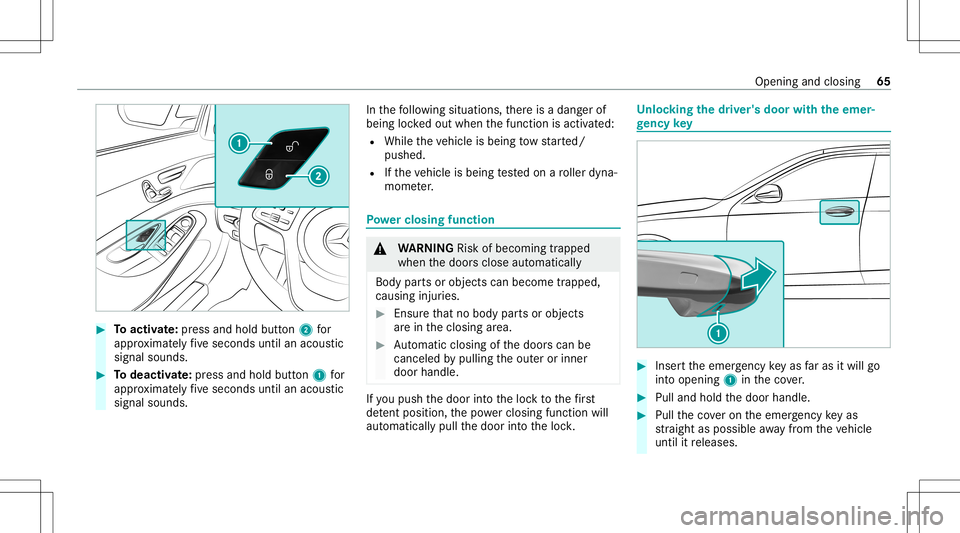
#
Toactiv ate: press and hold button2 for
appr oximat elyfive seconds untilanacous tic
signal sounds. #
Todeac tivate: press and holdbu tton 1 for
appr oximat elyfive seconds untilanacous tic
signal sounds. In
thefo llo wing situat ions,th er eis adang erof
being lockedout when thefunc tion isactiv ated:
R While theve hicle isbeing tow star ted/
pushed.
R Ifth eve hicle isbeing tested on aro ller dyna‐
mome ter. Po
we rcl os ingfun ction &
WARNIN GRisk ofbeco ming trap ped
whe nth edoor sclose automaticall y
Body partsor objec tscan become trapped,
causing injuries. #
Ensur eth at no body partsor obj ect s
ar ein theclosing area. #
Automatic closing ofthedoor scan be
canc eled bypulling theout eror inner
door handle. If
yo upush thedoor intoth eloc kto thefirs t
de tent positio n,thepo we rclosi ngfunction will
au tomatical lypull thedoor intoth eloc k. Un
loc king thedr iver' sdoor withth eemer ‐
ge ncy key #
Inser tth eemer gency keyas faras itwil lgo
int oopening 1intheco ver. #
Pull and hold thedoor handle. #
Pull theco veron theemer gency keyas
st ra ight aspossible away from theve hicle
until itre leases. Open
ingand closing 65
Page 70 of 510
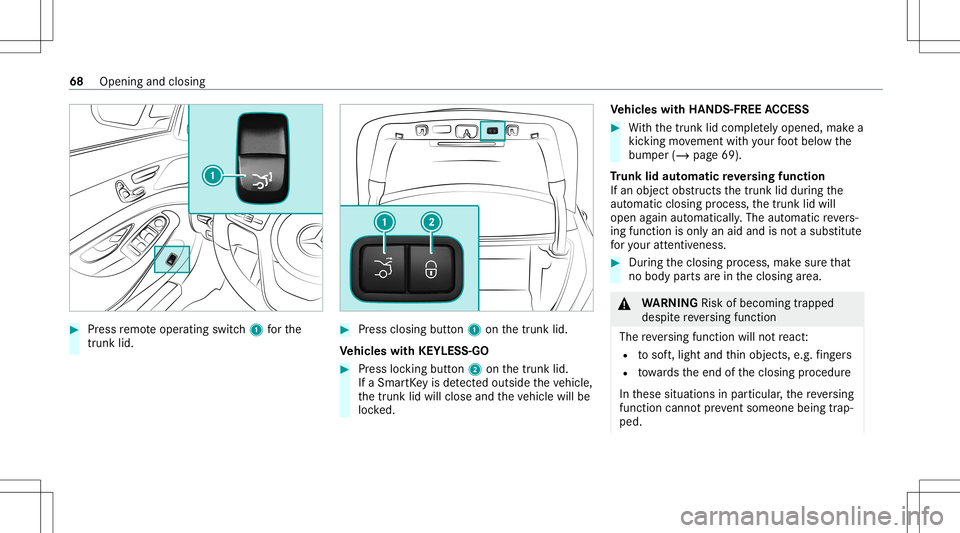
#
Press remo teoper ating switch1 forth e
tr unk lid. #
Pres sclo sing button 1 onthetrunk lid.
Ve hicl eswith KEYLESS-GO #
Press locking button2 onthetrunk lid.
If aSmar tKey isde tected outsid eth eve hicle,
th etrunk lidwill close andtheve hicle willbe
loc ked. Ve
hicl eswith HANDS -FREEACCESS #
With thetrunk lidcom pletely op ened ,ma kea
kic king movement withyo ur foot belo wthe
bum per(/ page69).
Tr unk lidaut omatic reve rsing funct ion
If an objec tobs truct sth etrunk liddur ing the
aut omat icclo singpr oce ss,thetrunk lidwill
open again automaticall y.The automatic reve rs‐
ing func tion isonl yan aid and isno ta subs titute
fo ryo ur att entiven ess . #
Dur ing theclosing process, makesur eth at
no body partsarein theclosing area. &
WARNIN GRisk ofbeco ming trap ped
des pite reve rsing func tion
The reve rsing func tion willnotre act :
R tosof t,light andthin obje cts, e.g. fing ers
R towa rdsth eend oftheclosing procedur e
In these situation sin par ticular ,th ere ve rsing
func tion cannotpr eve ntsom eone being trap ‐
pe d. 68
Opening andclosing
Page 72 of 510

When
making thekic king movement, makesur e
th at youar est andi ngfirm lyon thegr ound. You
cou ldother wise loseyour balan ce,e.g.on ice.
Obs erve thefo llo wing notes:
R The Smar tKey isbehin dth eve hicle.
R Stand atleas t12 in(30 cm) away from the
ve hicle while perform ing thekic king move‐
ment.
R Donotcome intocont actwithth ebum per
while making thekic king movement.
R Donotcar ryout thekic king movement too
slo wly.
R The kicking movement mustbe towa rdsth e
ve hicle andbackag ain. 1
Detection rang eof thesensor s
If se veralcon secut ive kic kin gmo vements are
no tsuccessfu l,wa itte nseco nds.
Sy stem limit s
The system maybe impair edorma yno tfunc tion
in thefo llo wing cases :
R The sensorsar edir ty,e.g. due toroad salt or
sn ow .
R The kicking movement ismade using apr os‐
th etic leg. The
trunk lidcould beopen edorclos edunin ten‐
tio nal ly,in thefo llo wing situat ions:
R Ifaper son 'sarms orlegs aremo vingin the
sensor detection rang e, e.g .wh en polishi ng
th eve hicle orpic king upobject s.
R Ifobject sar emo vedor placed behind the
ve hicle, e.g.tensi oni ng stra ps orlugg age.
R Ifclam ping stra ps, tarp sor other coverings
ar epu lled ove rth ebum per.
R Ifapr otect ive mat withalengt hre ac hin g
ov er thetrunk silldown intoth ede tection
ra ng eof thesensor sis used.
R Ifth epr otect ive mat isno tsecur edcor rectly .
Deacti vate KEYLESS- GO(/ page60) ordo not
car rytheSmar tKey about your per son insuc h
sit uatio ns. Swit
ching separ atetrunk locking onoroff If
yo ucen trall yunlo cktheve hicle while separate
loc king isactiv ated, thetrunk willremain locked. 70
Openin gand closin g
Page 84 of 510

st
ar tth eengine ifava lid Smar tKey has been left
inside theve hicle.
% Intheeve nttheengine cannotbe star ted
(y et theve hicle ’sbatt eryis ch arge d), the
sy stem isno toper ational. Contactan
aut hor ized Mercedes- BenzCenteror call
1-8 00-FOR-MER Cedes (intheUS A)or
1-8 00-387-0 100(in Canada). ATA
(anti-thef tala rm system) Fu
nction oftheATA system
If th eATA system isarmed, avisual andaudible
alar mistrigg ered inthefo llo wing situat ions:
R when adoor isopen ed
R when thetrunk lidisopened
R when thehood isopened
R when theglove boxis opened
The ATAsy stem isarmed automaticall yaf te r
appr oximat elyte nseco ndsinthefo llo wing situa‐
tion s:
R afte rloc king theve hicle withth eSmar tKey
R afte rloc king theve hicle using KEYLES S-GO Indicat
orlam p1 flashes whentheAT Asy stem
is armed.
The ATAsy stem isdeactiv ated aut omaticall yin
th efo llo wing situat ions:
R afte runloc kingtheve hicle withth eSmar tKey
R afte runloc kingtheve hicle using KEYLES S-
GO R
afte rpr essing thest ar t/ stop butt onwithth e
Smar tKey inthestow agecom partment
(/ page12 7)
% WhentheMer cedes‑ Benzemergency call
sy stem isactiv eand thealar mstay son for
mor eth an 30 sec onds, ames sageis aut o‐
mat icall ysen tto theCus tomer Assis tance
Ce nter (/ page 298) .
% Inthecase ofsevere batt erydisc harging,
th eanti- theftalar msystem isaut omatic ally
deactiv ated tofacil itat eth ene xt engine
st ar t.
Deact ivat ing theATA #
Press theÜ, ßor008B buttononthe
Smar tKey .
or #
Press thest ar t/ stop butt onwithth eSmar t‐
Ke yin themar kedspace (/page12 7)
Dea ctivat ingth eala rm using KEYLESS-GO #
Grasp theoutside doorhandle withth e
Smar tKey outside theve hicle. 82
Opening andclosing
Page 85 of 510
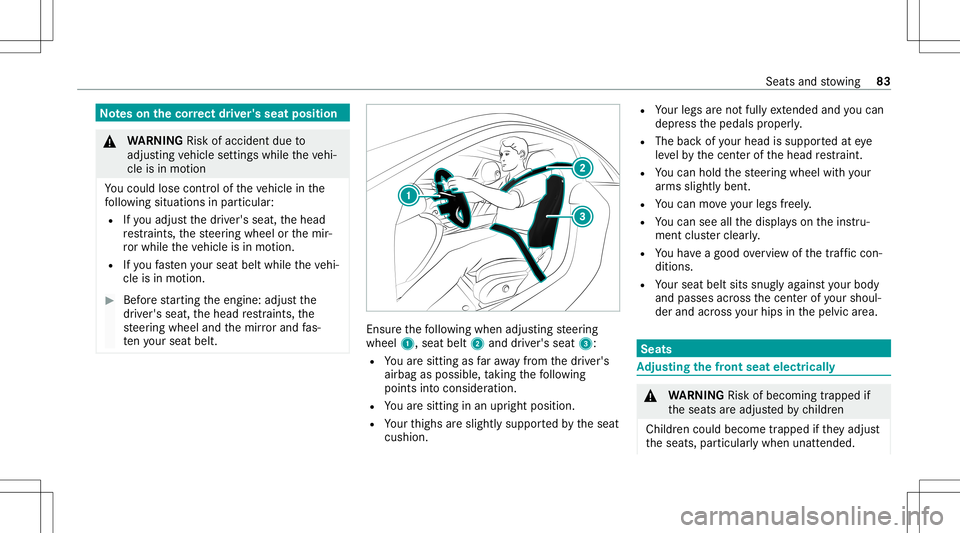
No
teson thecor rect driver' sseat position &
WARNIN GRisk ofacci dent dueto
adjus tingve hicle settin gswhile theve hi‐
cle isin mo tion
Yo uco uld lose contro lof theve hicle inthe
fo llo wing situat ionsinpar ticular :
R Ifyo uadj ustth edr iver's seat, thehead
re stra int s,thesteer ing wheel orthemir‐
ro rwhi letheve hicle isin mo tion.
R Ifyo ufa sten your seat beltwhile theve hi‐
cle isin mo tion. #
Beforest ar tin gth eengine: adjustth e
dr iver's seat, thehead restra int s,the
st eer ing wheel andthemir rorand fas‐
te nyo ur seat belt. En
sur eth efo llo wing when adjustingst eer ing
wheel 1,seat belt2and driver's seat 3:
R Youar esit tin gas faraw ay from thedr iver's
airbag aspossible, taking thefo llo wing
point sint ocon sider ation .
R Youar esit tin gin an upr ight position.
R Your thighs areslight lysuppor tedby theseat
cushion. R
Your legs areno tfull yex tende dand youcan
depr essthepedals proper ly.
R The backof your head issuppo rted ateye
le ve lby thecent erofthehead restra int .
R Youcan hold thesteer ing wheel withyo ur
ar ms sligh tly ben t.
R Youcan moveyour legs freel y.
R Youcan seeallthedispla yson theins tru‐
ment clusterclea rly.
R Youha ve agood overview of thetraf fic con‐
di tions .
R Your seat beltsitssn ug lyag ains tyo ur body
and pass esacr oss thecent erofyour sho ul‐
der and across your hips inthepelvic area. Seats
Ad
jus tingthe fron tse at elec tric all y &
WARNIN GRisk ofbeco ming trap ped if
th eseats areadjus tedby childr en
Childr encould becom etrapped ifth ey adjus t
th eseats, particular lywhen unattended. Seats
andstow ing 83
Page 86 of 510
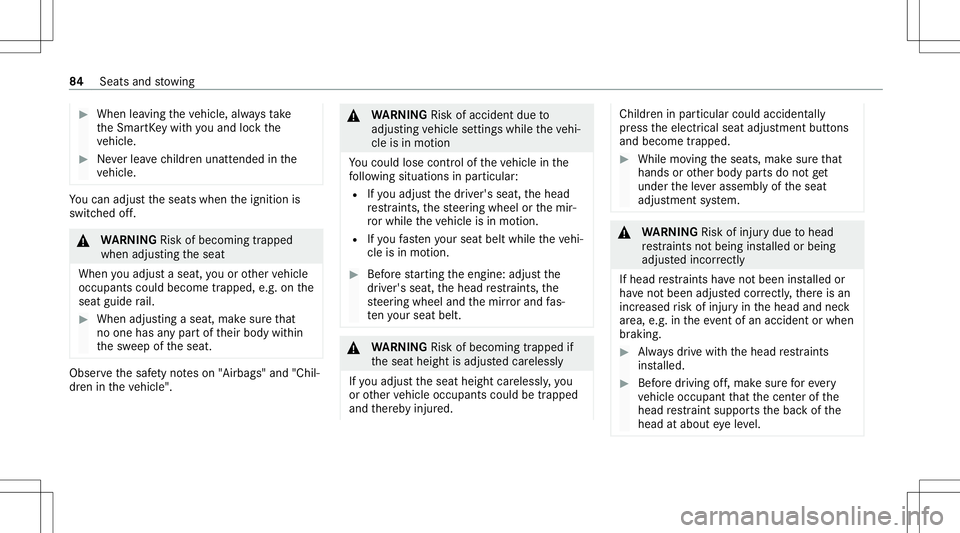
#
When leaving theve hicle, alwaysta ke
th eSmar tKey wit hyo uand lockth e
ve hicle. #
Neverlea vechildr enunat tende din the
ve hicle. Yo
ucan adjustth eseats when theignition is
switc hedoff. &
WARNIN GRisk ofbeco ming trap ped
whe nad jus ting theseat
When youadj usta seat ,yo uor other vehicle
occupants couldbecome trapped, e.g.onthe
seat guide rail. #
When adjustingaseat, makesur eth at
no onehas anypar tof their body within
th esw eep oftheseat. Obser
vethesaf etyno teson "Airbags" and"Chil‐
dr en intheve hicle". &
WARNIN GRisk ofacci dent dueto
adjus tingve hicle settin gswhile theve hi‐
cle isin mo tion
Yo uco uld lose contro lof theve hicle inthe
fo llo wing situat ionsinpar ticular :
R Ifyo uadj ustth edr iver's seat, thehead
re stra int s,thesteer ing wheel orthemir‐
ro rwhi letheve hicle isin mo tion.
R Ifyo ufa sten your seat beltwhile theve hi‐
cle isin mo tion. #
Beforest ar tin gth eengine: adjustth e
dr iver's seat, thehead restra int s,the
st eer ing wheel andthemir rorand fas‐
te nyo ur seat belt. &
WARNIN GRisk ofbeco ming trap ped if
th eseat height isadjus tedcar elessl y
If yo uadj ustth eseat height carelessly ,yo u
or other vehicle occupants couldbetrapped
and ther eb yinjur ed. Childr
eninpar ticular couldacciden tally
pr ess theelectr icalseat adjus tmentbutt ons
and become trapped. #
While moving theseats, makesur eth at
han dsorother body partsdo notget
und ertheleve rasse mbly oftheseat
adjus tmentsy stem. &
WARNIN GRisk ofinju rydue tohead
re stra int sno tbeing installed orbeing
adjus tedincor rectl y
If hea dre stra int sha ve notbe en installed or
ha ve notbe en adjus tedcor rectly ,th er eis an
incr eased risk ofinjur yin thehead andneck
ar ea, e.g. intheev ent ofan acciden tor when
br aking. #
Alw aysdr ive wit hth ehead restra int s
ins talled. #
Beforedr ivin gof f,mak esur efo rev ery
ve hicle occupant that thecent erofthe
head restra int suppor tsthebac kof the
head atabout eyeleve l. 84
Seatsand stow ing
Page 87 of 510
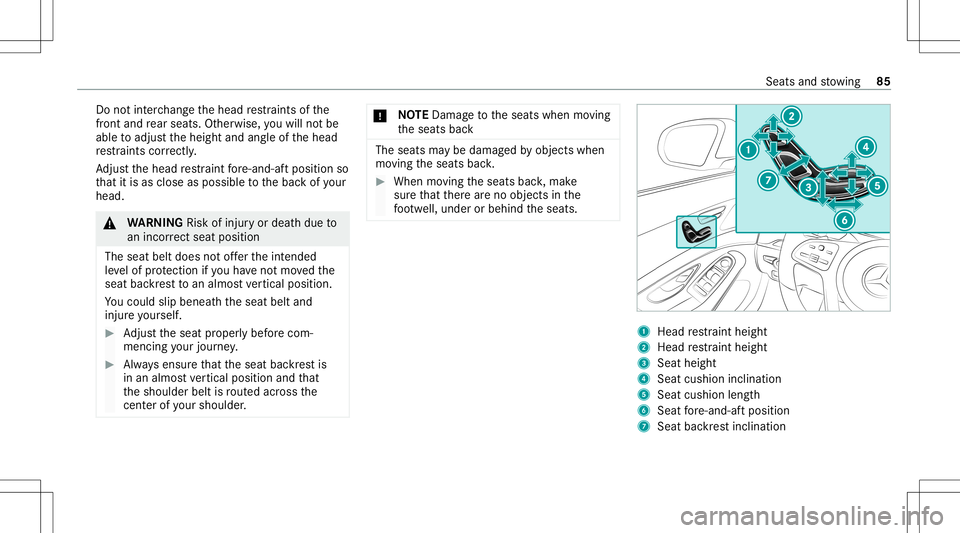
Do
notint erch ang eth ehead restra int sof the
fr ont and rear seat s.Ot her wise, youwill notbe
able toadjus tth eheight andangleof thehead
re stra int scor rectl y.
Ad jus tth ehead restra int fore -and -aftpos ition so
th at itis as clo seasposs ibletothebac kof your
head. &
WARNIN GRisk ofinju ryor deat hdue to
an incorrect sea tpos ition
The seatbel tdoe sno tof ferth eint ended
le ve lof protect ion ifyo uha ve notmo vedth e
seat backres tto an almos tve rtical posit ion.
Yo uco uld slip beneathth eseat beltand
injur eyo urself . #
Adjus tth eseat proper lybef orecom‐
menc ingyour jour ne y. #
Alw aysensur eth at theseat backres tis
in an almos tve rtical posit ionand that
th eshoulder beltisrouted acr oss the
cent erofyour sho ulder . *
NO
TEDama getotheseats when moving
th eseats back The
seats maybe damag edbyobject swhen
mo ving theseats back. #
When moving theseats back,mak e
sur eth at ther ear eno objec tsinthe
fo ot we ll,under orbehin dth eseats. 1
Head restra int height
2 Head restra int height
3 Seat height
4 Seat cushio ninc linat ion
5 Seat cushio nlengt h
6 Seat fore -and -aftpo sitio n
7 Seatba ckrest inc linat ion Seat
sand stow ing 85